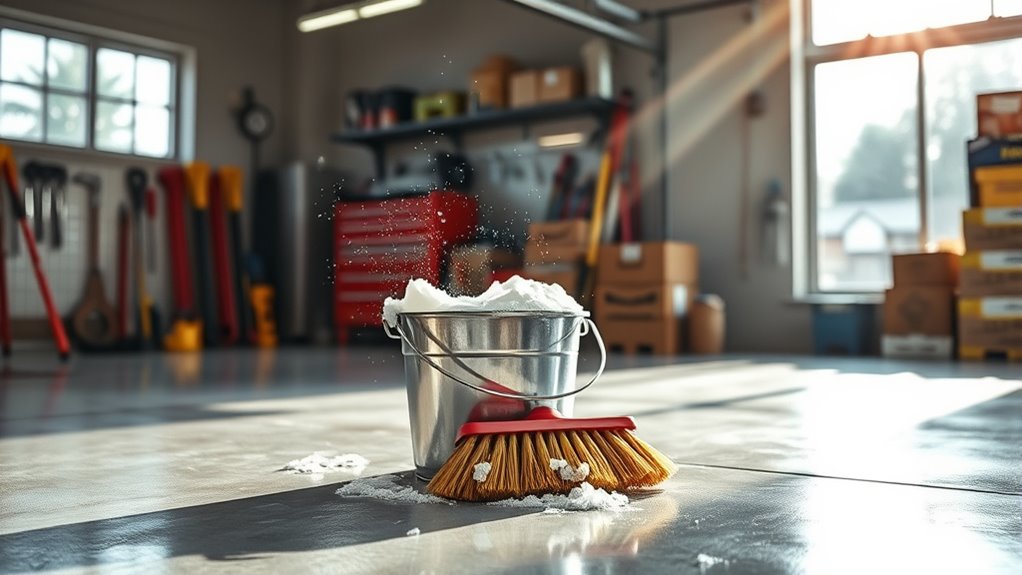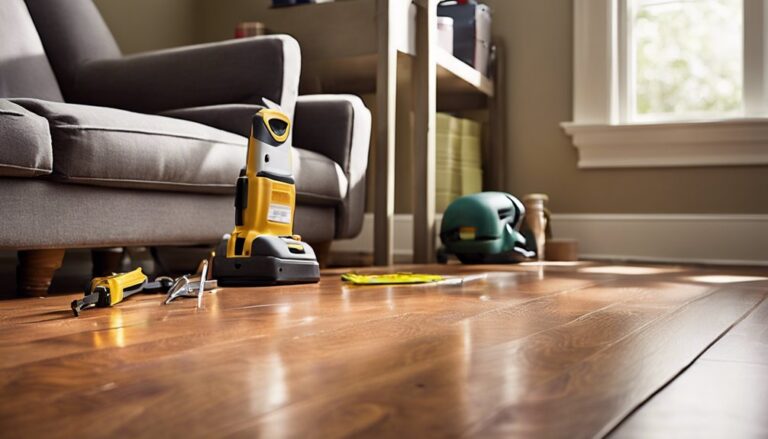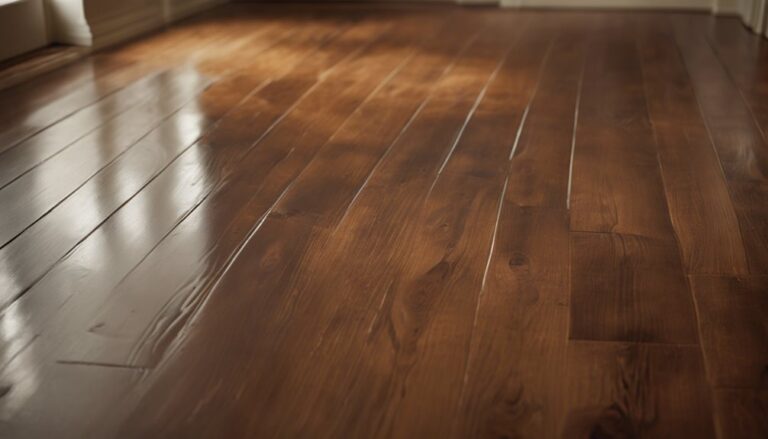To clean your garage floor concrete, start by removing vehicles and clutter, then sweep thoroughly with a stiff-bristle broom. Address oil stains promptly using an absorbent material followed by a concrete degreaser and scrubbing. Rinse with warm water and repeat if needed. For deeper cleaning, use a pressure washer and consider natural cleaners like vinegar or baking soda paste. Finish by drying with good airflow to prevent moisture damage. Further steps will guide you on maintenance and stain prevention.
Assessing the Condition of Your Garage Floor
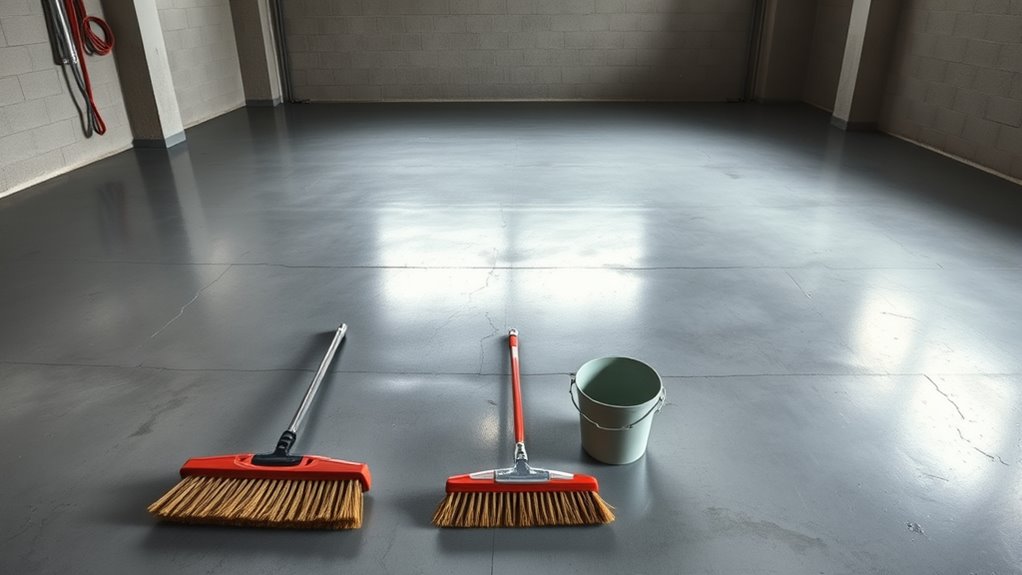
Before you begin cleaning, it’s vital to assess the condition of your garage floor thoroughly. Start with an extensive floor surface evaluation to identify any irregularities, stains, or embedded debris. Use a bright light to inspect the entire concrete surface systematically, focusing on cracks, chips, and discoloration. Conduct a damage inspection by noting the depth and extent of imperfections, as these factors influence your cleaning method and products. Pay special attention to areas with oil stains or chemical residues, as they may require specialized treatment. Documenting this data allows you to tailor your cleaning approach effectively, ensuring best results. A precise assessment grants you the freedom to address specific issues confidently, avoiding unnecessary effort or damage during cleaning. This methodical evaluation sets the foundation for a successful garage floor restoration.
Gathering Necessary Cleaning Supplies
Before you begin cleaning, gather essential tools like a stiff-bristle brush, mop, and bucket. Select cleaners specifically designed for concrete to guarantee effective stain removal without damage. Don’t forget safety gear such as gloves and goggles to protect yourself during the process.
Essential Cleaning Tools
To effectively clean your garage floor concrete, you’ll need a specific set of tools designed for heavy-duty cleaning and debris removal. Start with durable cleaning equipment such as stiff-bristled brooms and heavy-duty dustpans to clear loose dirt and debris. A long-handled scrub brush will help you reach corners without strain. For larger surfaces, a floor scrubber is indispensable—it offers consistent pressure and scrubbing motion, guaranteeing deeper grime removal with less effort. Additionally, consider a wet-dry vacuum to efficiently extract water and loosened dirt after scrubbing. Rubber gloves protect your hands during the process, while a sturdy bucket will hold your cleaning solutions. Collecting these precise tools guarantees you maintain control and freedom throughout the cleaning, making the task systematic and effective.
Choosing Effective Cleaners
Although selecting the right cleaning tools is essential, choosing effective cleaners is equally important for thoroughly removing stains and grime from garage floor concrete. You’ll want to select cleaning agents specifically formulated for concrete surfaces, as generic cleaners might not address the porous nature of the material. Consider the surface types present—whether sealed or unsealed concrete—as this affects cleaner compatibility. For unsealed concrete, alkaline-based cleaners excel at breaking down oil and grease, while sealed surfaces tolerate a broader range of agents, including mild detergents. Avoid acidic cleaners on unsealed concrete to prevent etching. Always verify product labels for intended surface types and stain compatibility. By methodically matching cleaning agents to your garage floor’s conditions, you guarantee ideal stain removal while preserving surface integrity, granting you the freedom to maintain a pristine space efficiently.
Safety Gear Preparation
Two essential categories of supplies you’ll need for cleaning garage floor concrete are personal safety gear and cleaning tools. Before starting, confirm you equip yourself with protective eyewear to shield your eyes from chemical splashes and debris. Rubber gloves are mandatory to protect your hands from harsh cleaners and prolonged moisture exposure. Select gloves that fit snugly and resist punctures. For cleaning tools, gather stiff-bristled brushes, a mop, and a bucket. Also, prepare absorbent rags or towels for spills. Verify all safety gear is intact and comfortable to avoid distractions during cleaning. Prioritize safety to maintain your freedom of movement and prevent injuries. Proper preparation confirms the cleaning process is efficient, controlled, and safe.
Clearing and Preparing the Garage Space
Before you begin cleaning the concrete floor, you’ll need to clear the garage completely to guarantee unobstructed access. This step guarantees efficiency and safety during the cleaning process. Start by:
- Removing all vehicles and large equipment to create a wide workspace.
- Organizing tools systematically, placing them on shelves or in toolboxes.
- Decluttering items scattered on the floor, sorting them into keep, discard, or relocate piles.
- Confirming that chemical products and flammable materials are stored safely away from the work area.
Completing these tasks provides a clean slate, allowing you to focus solely on the concrete surface. By methodically clearing and preparing your garage, you set the stage for a thorough, unrestricted cleaning process that maximizes your freedom to move and work effectively.
Removing Loose Dirt and Debris
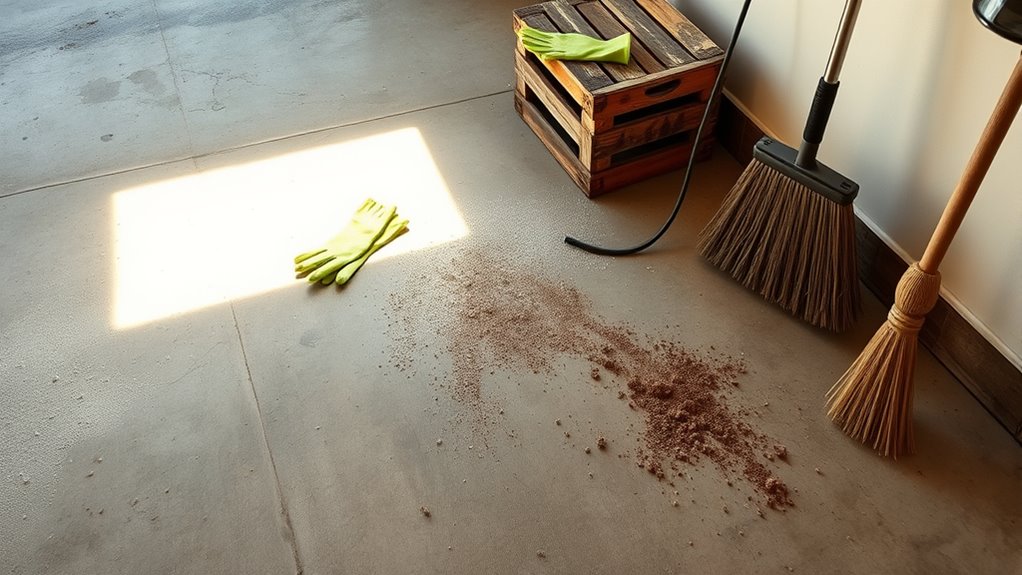
Before applying any cleaning agents, you’ll need to remove all loose dirt and debris from the garage floor. Start by sweeping systematically with a stiff-bristle broom to gather particles into manageable piles, then use a shop vacuum to capture finer dust and grit. Proper pre-cleaning preparation guarantees that the concrete surface is ready for deeper cleaning steps.
Sweeping Techniques
Although it may seem straightforward, effective sweeping requires a systematic approach to confirm all loose dirt and debris are thoroughly removed from your garage floor. Mastering sweeping techniques guarantees peak debris removal, preparing the surface for deeper cleaning.
Follow these steps for precision:
- Start at the farthest corner, working toward the exit to avoid retracing steps.
- Use a stiff-bristled broom to dislodge embedded particles effectively.
- Sweep in short, controlled strokes, directing debris into manageable piles.
- Collect debris with a dustpan promptly to prevent scattering.
Using a Shop Vacuum
Once you’ve swept the garage floor thoroughly, using a shop vacuum is the next step to remove remaining loose dirt and fine debris that sweeping may miss. The shop vacuum benefits include powerful suction and specialized attachments that reach cracks and corners inaccessible to brooms. Begin by selecting the appropriate nozzle, typically a wide floor brush for open areas and a crevice tool for edges. Move systematically in overlapping passes to guarantee thorough coverage without missing spots. Maintain a steady pace; too fast reduces suction effectiveness, too slow wastes time. Empty the vacuum canister regularly to sustain peak performance. Employing these shop vacuum techniques enhances your cleaning efficiency, freeing you from lingering dust and particles, and preparing the concrete for deeper cleaning steps. This methodical approach maximizes cleanliness with minimal effort.
Pre-cleaning Preparation
To effectively prepare your garage floor for deep cleaning, start by removing all loose dirt and debris through systematic sweeping and vacuuming. Establishing a consistent cleaning schedule guarantees peak floor maintenance and prolongs concrete durability. Follow these steps:
- Clear the area of items to access the entire surface.
- Use a stiff-bristled broom to sweep dust, leaves, and grit into manageable piles.
- Employ a shop vacuum to extract fine particles embedded in cracks and pores.
- Inspect the floor for stubborn debris or stains needing targeted pre-treatment.
Tackling Oil and Grease Stains
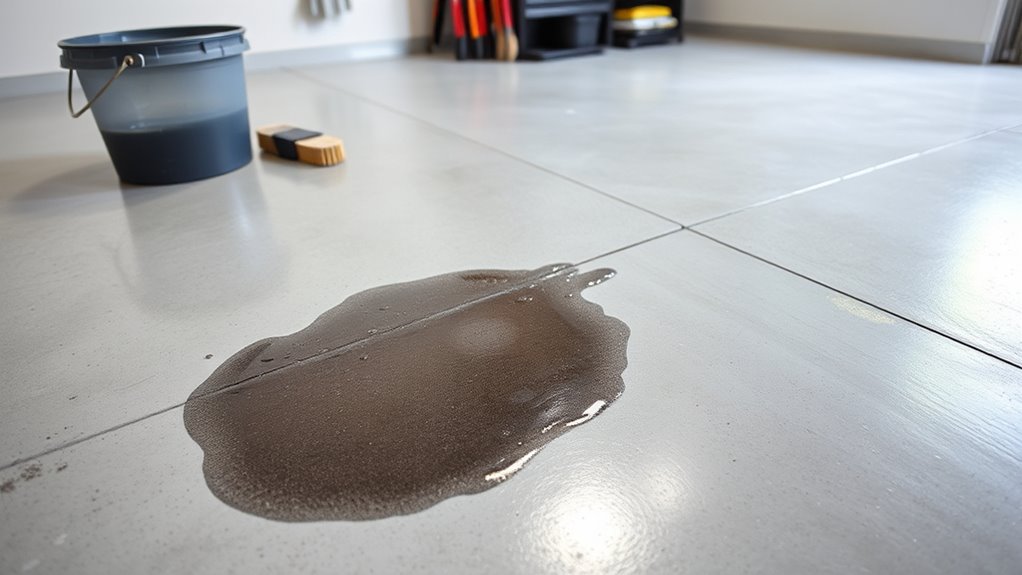
When dealing with oil and grease stains on concrete, it’s essential to act promptly to prevent deep absorption. Start by covering the stain with an oil absorbent like cat litter or sawdust; let it sit for several hours to draw out excess oil. Sweep up the absorbent thoroughly. Next, apply a specialized concrete degreaser or a strong detergent directly to the stain. Use a stiff-bristled brush to agitate the area methodically, enhancing stain removal. Rinse with warm water and inspect the stain. Repeat the treatment if necessary, as multiple applications may be required for stubborn marks. By following these precise steps, you maintain the freedom to keep your garage floor pristine without resorting to harsh chemicals or professional services prematurely.
Deep Cleaning the Concrete Surface
After addressing localized stains like oil and grease, it’s important to move on to a thorough cleaning of the entire concrete surface. Employing effective deep cleaning techniques guarantees your garage floor maintains durability and appearance. Start by:
- Sweeping the floor to remove loose dirt and debris.
- Applying a concrete-specific degreaser and letting it sit as per instructions.
- Scrubbing the surface systematically with a stiff-bristle brush or floor scrubber to penetrate pores.
- Rinsing thoroughly with a pressure washer or garden hose to wash away residues.
These concrete maintenance tips not only restore cleanliness but also prevent future buildup, granting you the freedom to use your space confidently. Regular deep cleaning extends the lifespan of your concrete, keeping it safe and visually appealing.
Using Natural and Homemade Cleaning Solutions
Although commercial cleaners are effective, you might prefer natural and homemade solutions for their cost-efficiency and reduced chemical exposure. To prepare a basic natural cleaner, mix equal parts white vinegar and water in a spray bottle. This solution effectively breaks down grease and grime on concrete. For tougher stains, combine baking soda with water to form a paste, then apply it directly to the stain and let it sit for 15 minutes before scrubbing with a stiff brush. Another homemade solution involves mixing hydrogen peroxide with a few drops of dish soap, which can target oil-based stains without harsh chemicals. These natural cleaners allow you to maintain your garage floor safely while minimizing environmental impact, giving you freedom from toxic residues and unnecessary expenses.
Rinsing and Drying the Floor Properly
Once you’ve thoroughly scrubbed the garage floor, it is crucial to rinse away all cleaning residues to prevent slippery surfaces and soap buildup. Employ an effective rinse technique by following these steps:
Thorough rinsing after scrubbing prevents slippery residue and ensures a safe, clean garage floor.
- Use a hose with a spray nozzle set to medium pressure to avoid damaging the concrete.
- Start rinsing at the highest point of the floor, allowing water to flow toward the drain or exit.
- Rinse methodically in overlapping sections to guarantee complete removal of cleaning agents.
- Remove excess water promptly using a squeegee or wet vacuum.
For drying methods, maximize airflow by opening garage doors and windows or using fans. This prevents moisture retention, which can cause staining or mold. Proper rinsing and drying grant you a clean, safe floor ready for unrestricted use.
Preventative Tips to Keep Your Floor Clean Longer
To maintain the cleanliness of your garage floor concrete over time, it is essential to implement preventative measures that minimize dirt accumulation and damage. Start by placing durable floor mats at entry points to trap dirt, oil, and moisture before they reach the concrete surface. Choose mats designed for heavy-duty use to maximize protection. Incorporate regular maintenance routines such as sweeping debris daily and promptly wiping spills to prevent stains and degradation. Avoid harsh chemicals that can erode the concrete or protective sealants. Additionally, inspect your floor periodically for cracks or wear and address them immediately to prevent further damage. By combining strategic use of floor mats with consistent upkeep, you’ll extend the floor’s lifespan and maintain a clean, safe garage environment that supports your freedom to use the space unimpeded.

